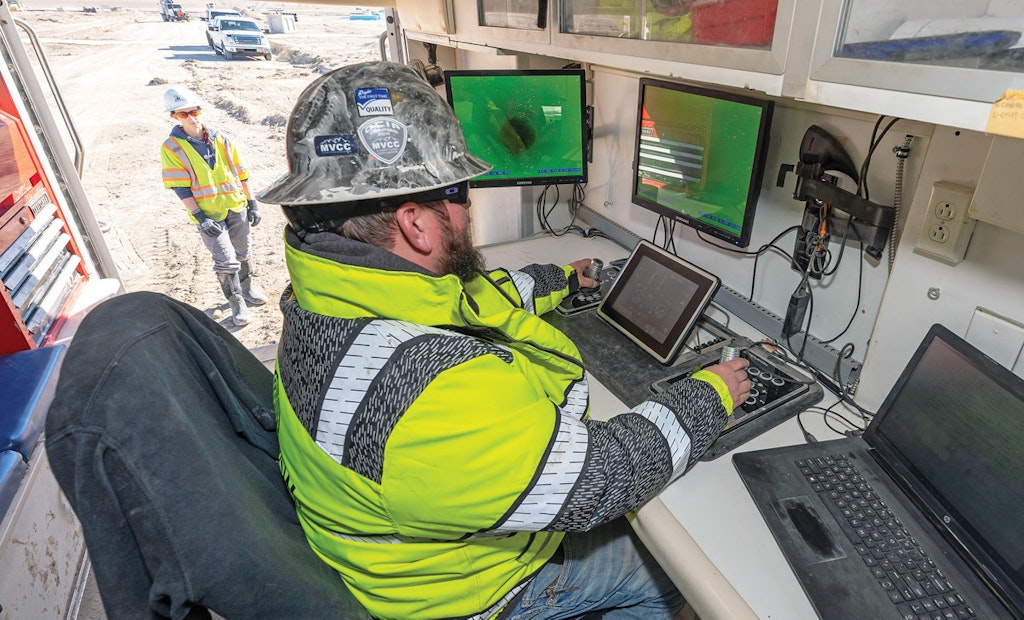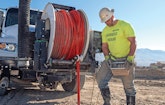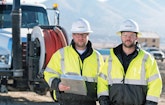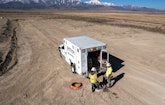
Tanner Waters operates a ROVVER X camera system during an inspection while Meagan Allred watches over the access point.
Interested in Municipal/Industrial?
Get Municipal/Industrial articles, news and videos right in your inbox! Sign up now.
Municipal/Industrial + Get AlertsThe history of PipeView Services is a tale of too much or too little growth. Since 2015, owners of the Lehi, Utah, company have wrestled with how rapidly to expand the organization and its customer base. Current owner Joseph Turley now has settled on a multifaceted plan for steady growth.
The company expansion is keyed to new marketing, more services and greater customer loyalty. It’s a formula for longevity as well as growth.
Seeing potential
The company was started in 2015 by a trio of investors already involved in the construction industry in northern Utah. The principal owner, Brett Johnson, saw a need for a pipe inspection and cleaning company in fast-growing Lehi. He and his partners bought an old Vac-Con hydrovac truck and a used CUES sewer inspection camera and hung out their shingle.
Unfortunately, the shingle attracted too much business. “They wanted to keep the company small, work it as a side business,” Turley says of the original company owners. “It started getting a little bigger and then got too big for them. We saw the potential for the company to grow way bigger than it was and purchased it.”
“We” in this case was Joseph and his younger brother, Justin. They also were in the construction industry in 2018 when they took over PipeView Services, operating a construction cleanup firm in Twin Falls, Idaho. Today, 34-year-old Justin runs the Idaho enterprise and Joseph, 40, operates the Utah company. They collaborate on marketing and have a common strategic vision, but otherwise individually focus on managing their respective companies.
Lehi, Utah, is a burgeoning community. Its population jumped to 75,000 in 2020 from 47,000 the previous census. Technology companies like Microsoft and Adobe have supplanted the former agricultural economy. Situated south of Salt Lake City nearer Provo, Lehi is part of the bustling Salt Lake Valley ecosystem.
“Utah County is exploding right now,” Turley says. “Eighty-five percent of our work is in southern Salt Lake and Utah counties, within 30 to 40 miles of Lehi.” His trucks have also made runs to Logan in northern Utah and south to St. George, Utah, for example, and frequently are in and out of Park City, but Lehi remains the business core.
“Ninety-nine percent of Lehi’s growth is positive,” Turley says of the population boom. “It leads to more construction projects, which is more work for us. The only negative is the traffic. It takes us longer now to get from job to job.”
Most of those jobs are with general contractors, some of whom are working to construct freeway lanes to handle all the valley traffic. One such project is the Mountain View Corridor, which eventually will be a 35-mile freeway in the valley, south from I-80. For Turley’s company, that project means miles and miles of new roadway with numerous storm drains bisecting them, all of which need cleaning and inspection.
While such a concentration of work bodes well for the company, Turley is working to diversify his customer base. Specifically, he is targeting the valley’s municipalities. To that end, the company has partnered with a Georgia firm offering the Echologics leak detection system, which can find pipe leakage early on before a pipe bursts. “We’re the Utah contractor for Echologics now and specialize in leak detection on water lines.”
New services
Other growth strategies include promotion of the brand. The original owners relied on word of mouth, but Turley started a marketing campaign to “get the name out there. We’re getting a lot more small companies that didn’t even know we existed before. We had two main customers when we took over, but we have seven now and more than 50 smaller contractors that don’t have the volume of work to use us as often but are good customers.”
He’s trying to convert some frequent users of his services into preferred customers, with exclusivity agreements that incorporate a price break for the customer. The approach is gaining traction, Turley says. “We’ve increased the loyalty of our customers.”
The final component in the company’s growth strategy is expansion of services. The pipe cleaning and inspection company first expanded into pressure testing, a natural extension of its original work. Manhole inspection, cleaning and air testing followed. Point repairs in pipelines were next up along with chemical grouting rehab work on manholes.
“They are all based on our inspection and testing work,” Turley says. “They are all complementary services. When we found a cracked pipe, for example, we wanted to be able to fix it for the customer. We want to be a one-stop shop.”
Customers only need point repair work two or three times a month, Turley says, but PipeView Services crews can do it when needed. The repairs are all patches, so typically pipes aren’t excavated and replaced. “Our repairs are more minimalist, like a crack along a joint.” The usual repair method is insertion of a Source One Environmental or NuFlow CIP sleeve.
Another new service that has taken off is potholing. “That has really gotten big for us in the last 10 months or so, as soon as we got the right equipment to do it,” Turley says. “The work probably was there all along, but we didn’t have the right equipment before. As soon as we did, a lot more companies started asking for it.”
Gone is the old Vac-Con rig. The “right equipment” turned out to be a pair of Vactor 2100 trucks, with 10-yard and 12-yard debris bodies and 1,500-gallon water tanks. More recently, the company bought a Vacall combo truck, configured similarly and more automated, “and we really, really like it.”
The other primary pieces of equipment for inspection work are Envirosight cameras. Turley has two ROVVER X models. He swears by the camera’s optics and maneuverability, but also likes the fact they are easier to manhandle than the camera system they replaced. “They’re a lightweight camera, weighing maybe 30 or 40 pounds versus the 120 pounds of the old camera. They’re just a whole lot easier to get into a pipe, into a manhole.”
All the pieces of Turley’s strategy have worked well enough to triple business volume in the last three years, with quadrupling almost a reality.
Embracing opportunities
In July 2021 in Salt Lake City, PipeView Services was called to check the sewer system at Rice-Eccles Stadium on the campus of the University of Utah.
A Garth Brooks Stadium Tour performance was scheduled on a Friday. Turley’s crew showed up on Monday of that week to make sure the stadium’s sewer lines were ready to handle the crowd. They weren’t.
“We found some sewer lines that were unknown to exist at that time. They were completely blocked,” he recalls. The crew spent the next three days clearing them. Tens of thousands of country music fans never knew how close they came to having their fun flushed right down the drain. “We saved the concert, and nobody knows it!” Turley says.
The company is small at this moment, with eight employees. They are a young team — most in their 20s and 30s — yet several crew members have five or six years of experience. Morale is high, Turley says, with fast growth, new machinery, profit sharing in the works and limitless opportunity stretching out ahead.
The company is highly certified, with all operators credentialed for pipeline, manhole and lateral assessment work as well as concrete coating. “All of that means we know how to find solutions some other companies don’t know how to find,” Turley says.
The brothers have a plan — actually, one-, five- and 10-year plans — for building out PipeView Services into a regional company also serving parts of Idaho, Nevada and Arizona. “Once we settle in where we are happy with what we offer, we’ll expand,” Turley says.
In the interim, that means continuing to instill in company personnel the critical need to clearly communicate with customers at all times and master the growing suite of services. It’s all about keeping a handle on the day-to-day and managing success. With a pair of business degrees under his belt, Turley feels up to the task.
“Growth is expensive. You have to have a financial plan to grow successfully; otherwise you will grow yourself out of business. It is so easy to run out of money when you are trying to grow and expand,” he says. “Financial planning is critical. Sometimes you don’t even realize a financial dip is there until it’s too late to react. With a good financial plan, you can see three or four months in advance and can prepare for a dip.”










